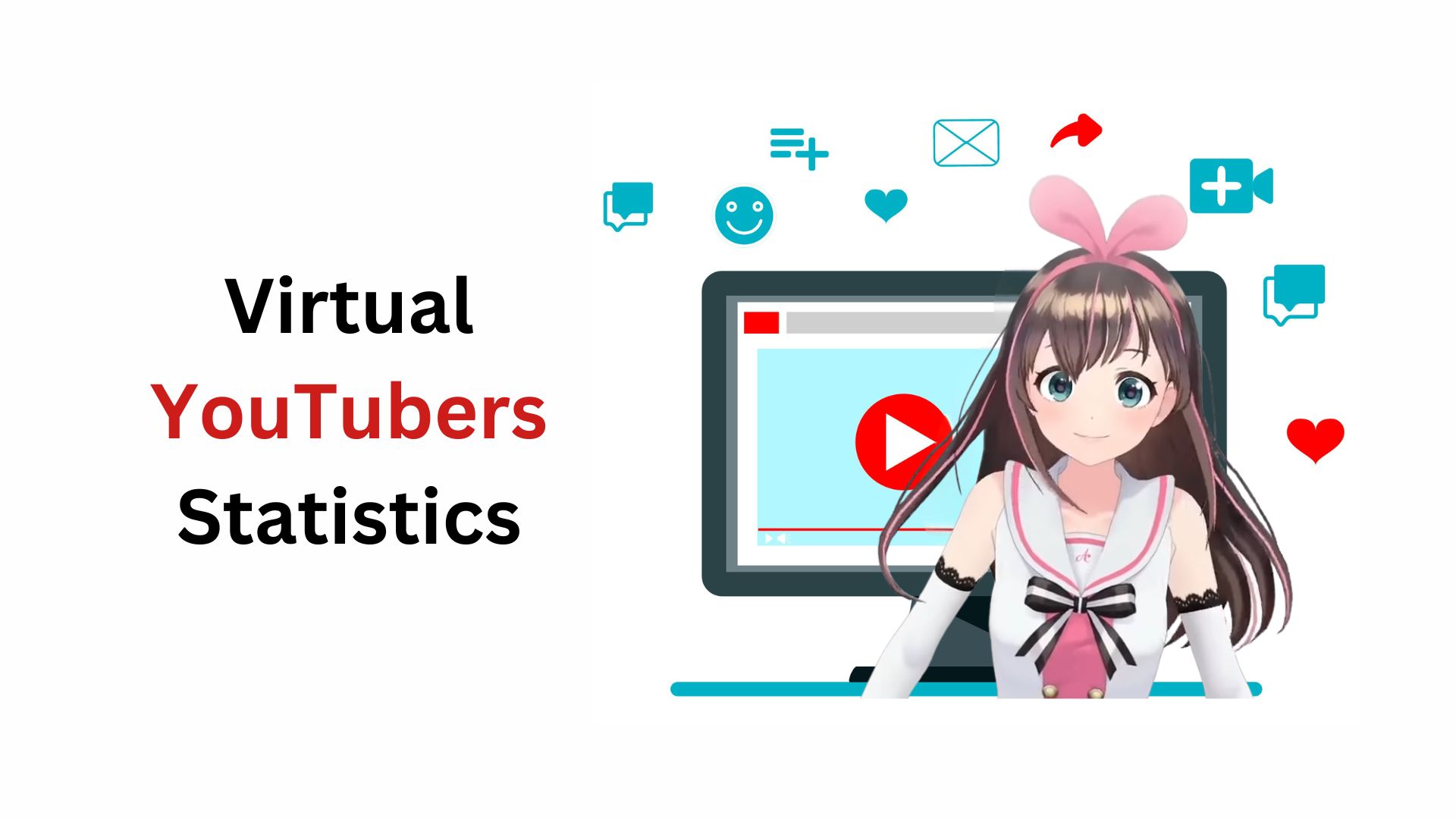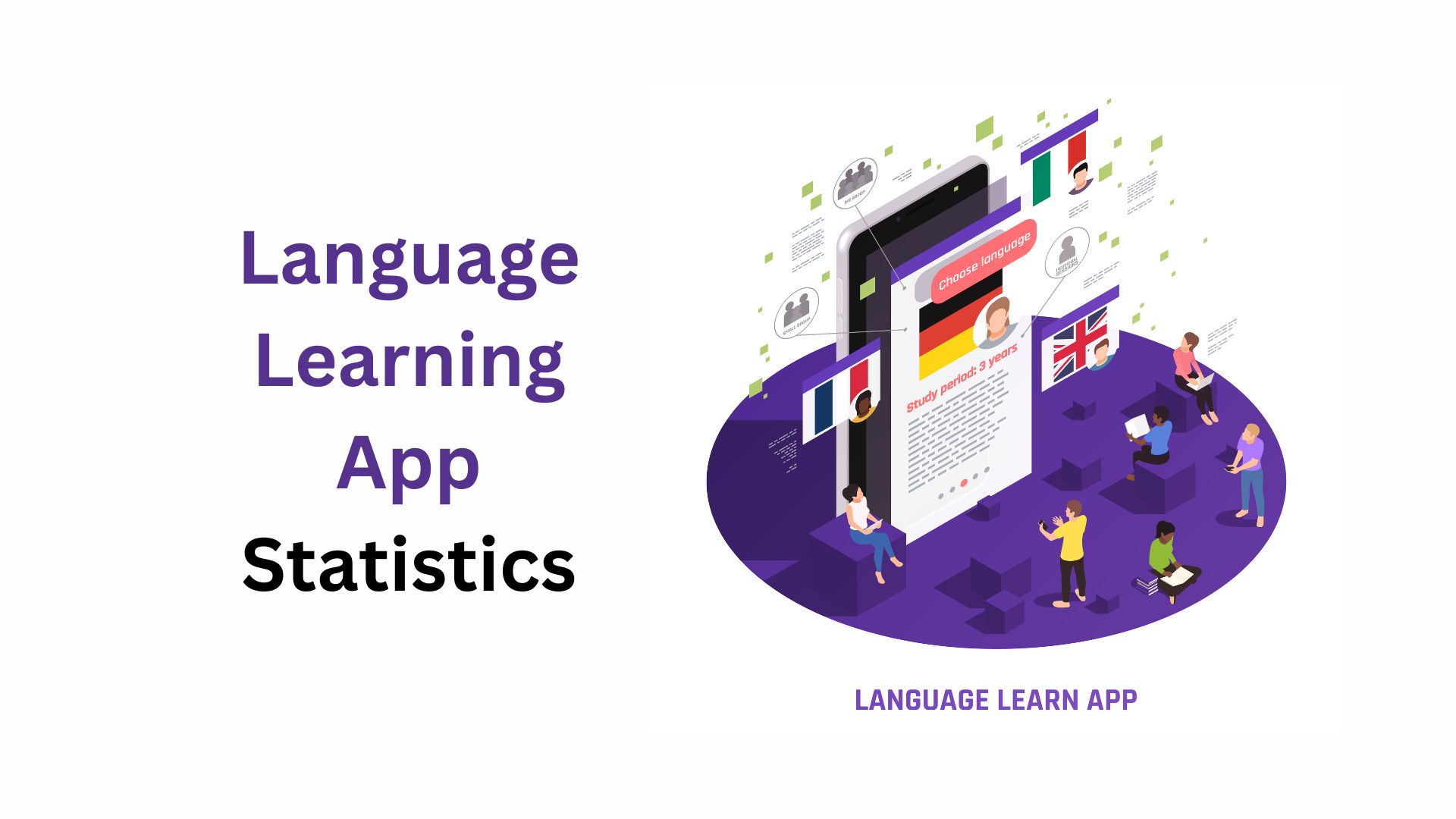AI In Education Statistics By Usage, Adoption and Facts (2025)
Updated · Nov 03, 2025

Table of Contents
- Introduction
- Editor’s Choice
- AI In Education Market Size
- Use of AI In The Classroom For Research
- Usage of AI Education
- Most Preferred AI Tools In Education
- Use AI In Education By Teachers
- How AI Shapes Student Learning
- AI Training And Professional Development In Education
- Benefits of AI In Education By Countries
- AI In Education – Differences In Gender And Attitude of Usage
- Challenges And Limitations of AI In Education
- Conclusion
Introduction
AI in Education Statistics: AI smartly and unexpectedly came to the classrooms just like an unseen but very effective tutor ghost. By 2025, the use of AI had pervaded various aspects of education, including grading, planning, teaching, writing, and adaptive practices, in schools, universities, and among teachers and students.
The numbers indicate a remarkable transformation brought about by high-tech gadgets and great teaching strategies. We will present the AI in Education statistics and trends that give the strongest indication of the revolution of artificial intelligence in education in this article.
Editor’s Choice
- According to Market.us, The Global AI in Education Market is expected to reach USD 73.7 Billion by 2033, growing from USD 3.6 Billion in 2023 at a CAGR of 35.10% from 2024 to 2033.
- 47.3% of Cambridge students are enabled by AI chatbots to finish their degree requirements.
- Teachers and AI collaborate in lesson design, where approximately 50% of the total teachers initially enhance their teaching with these tools, driven by the effectiveness and creativity they create.
- 44% are educators using AI in research, 38% in lesson planning, and 37% in generating classroom materials.
- In the U.S., 43% of college students apply AI tools such as ChatGPT, among whom 90% assess it as more effective than standard tutoring.
- Student groups aged 14 to 22 are the largest users of AI, with 51% preferring to use generative AI for learning and creativity.
- The leading AI apps for students globally are ChatGPT (66%), Grammarly (25%), and Microsoft Copilot (25%).
- Students using Microsoft 365 Copilot Chat have been associated with a 15% uplift in Windows and a 275% acquisition of learning independence, so to speak.
- 83% of K-12 teachers engage with generative AI, and within that context, 60% of all teachers are said to incorporate AI into their lessons.
- At Macquarie University, AI utilisation resulted in an increase of up to 10% in student exam results and thus clear academic benefits.
- By Fall 2025, 74% of school districts are expected to start offering AI training sessions for teachers. Currently, however, 71% of U.S. K-12 teachers lack formal training on the issue.
- The alien investment ranks first in the U.S. with US$109.1 billion, while China (US$9.3B) and the U.K. (US$4.5B) are far behind.
- The year 2025 marked a significant increase in student use of AI, from 66% in 2024 to 92%, accompanied by a corresponding rise in the use of generative AI for assessments, from 53% to 88%.
- Plagiarism and cheating are reported by 72% of educators as the primary concerns regarding AI, while 93% assert the need for regulations.
AI In Education Market Size
- The Global AI in Education Market is expected to reach USD 73.7 Billion by 2033, growing from USD 3.6 Billion in 2023 at a CAGR of 35.10% from 2024 to 2033.
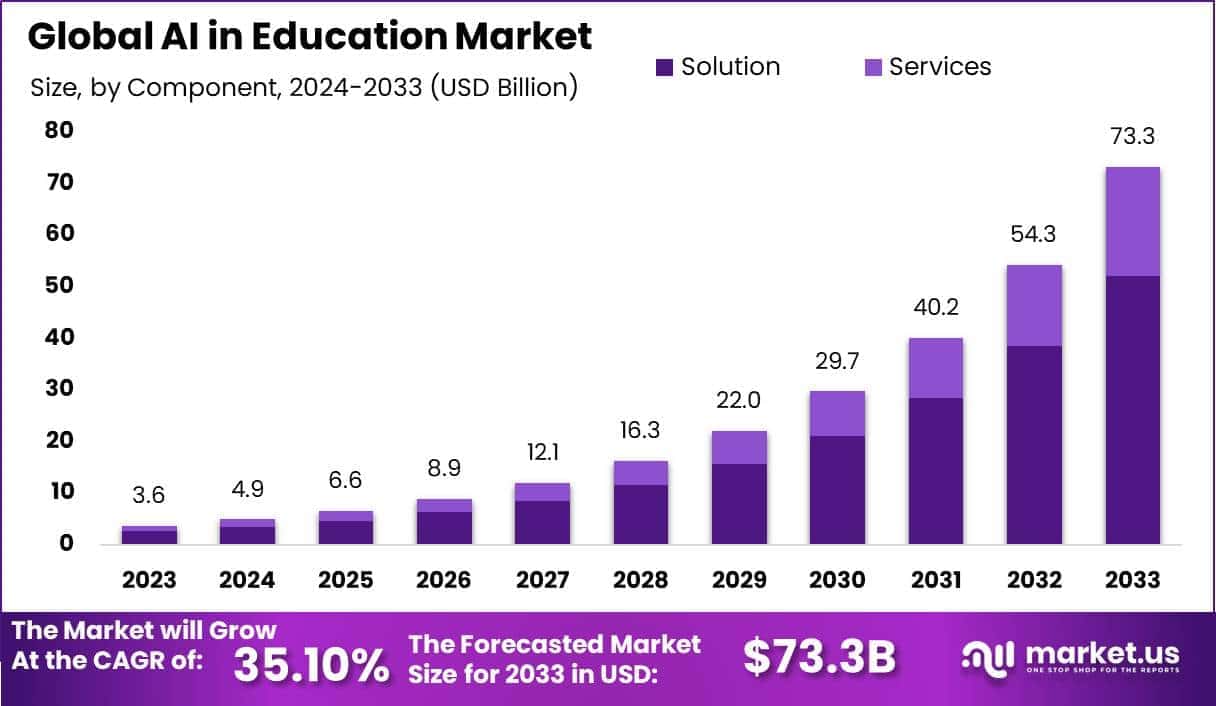
(Source: Market.us)
- Analysts have observed strong market potential and growth momentum in the education sector due to increasing AI adoption.
- Chinese edtech startup Squirrel AI Learning raised USD 150 million in 2022 at a USD 2 billion valuation, reflecting strong investor confidence in adaptive learning platforms.
- Studies have shown that AI-powered tutoring systems can enhance student engagement and performance by up to 30%, indicating measurable learning benefits.
- The State of AI in Education Survey by Quizlet revealed that 42% of respondents believe AI helps make education more equitable, while 24% reported no impact, showing mixed but largely positive views on AI’s role in fairness.
- Over USD 9.5 billion was raised by edtech companies during the first two quarters of 2023, highlighting increasing investor interest in AI-driven learning solutions.
- A Blackboard survey found that 64% of educators believe AI improves their ability to deliver personalized instruction, reflecting optimism toward AI integration in teaching.
- AI-based grading systems are projected to automate grading for nearly 100% of multiple-choice tests and 50% of essays in higher education by 2024, increasing efficiency in academic assessment.
- Integration of Virtual Reality (VR) and Augmented Reality (AR) with AI is anticipated to offer more immersive and interactive learning experiences.
- The Solution segment accounted for over 71% of the market share in 2023, supported by the demand for AI tools that enhance personalized learning and streamline operations.
- Cloud deployment dominated with more than 56% of the market in 2023, due to benefits like scalability, cost-efficiency, and flexibility.
- Machine Learning technology led the market with over 60% share in 2023, as it supports data-driven and adaptive educational systems.
- Learning Platforms and Virtual Facilitators represented over 46% of the market share in 2023, reflecting the strong demand for advanced AI-based learning environments.
- The Higher Education segment held over 42% of the market in 2023, as universities adopt AI to improve research, administration, and customized learning.
- North America captured more than 36% of the global market share in 2023, maintaining regional dominance through early adoption of AI tools and strong technological infrastructure.
Use of AI In The Classroom For Research
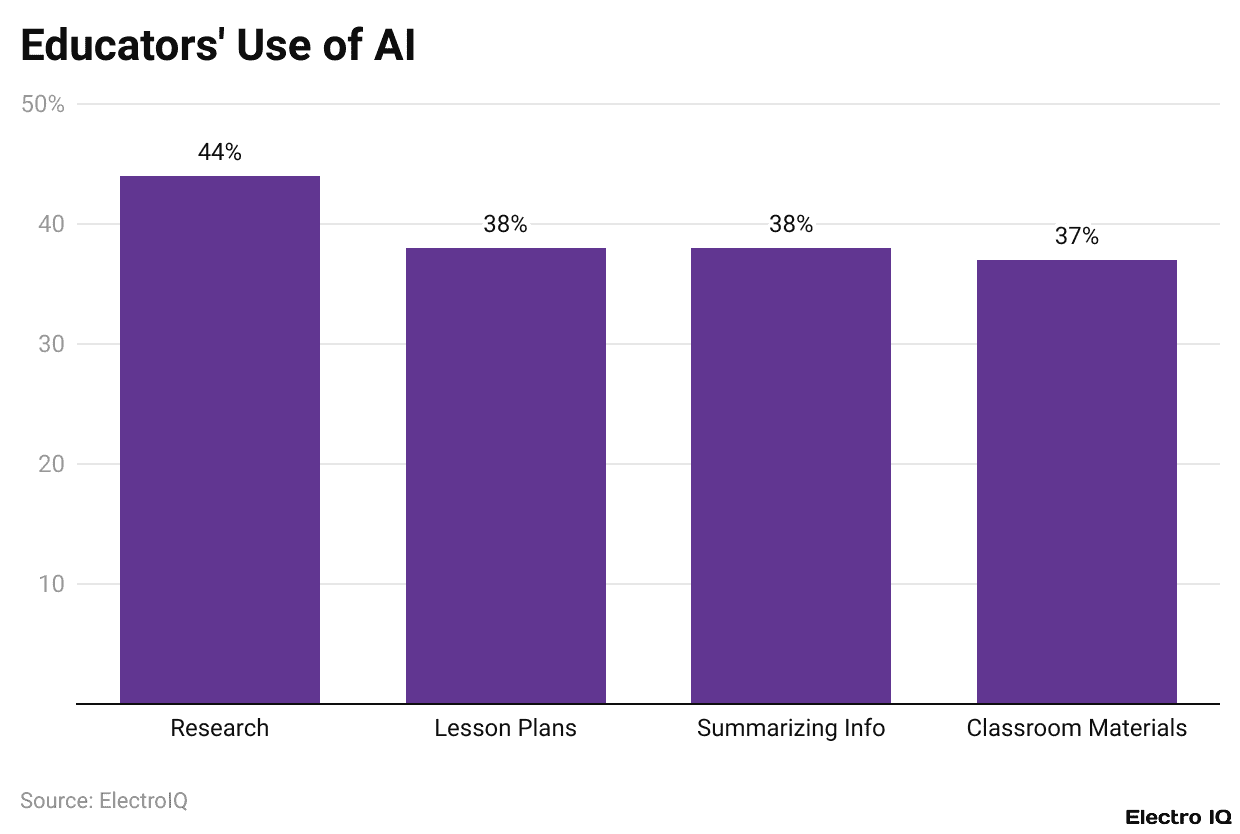
(Reference: allaboutai.com)
- In 2023, a survey conducted by Quizlet indicated that teachers had started to apply AI tools in certain crucial areas of the classroom.
- The majority of teachers resort to AI for research (44%), lesson planning (38%), summarising information (38%), and materials generation, like tests and assignments (37%).
- The increasing reliance on AI in the classroom supports and also reflects a general trend towards technology-based education.
- PR Newswire reports that both learners (47%) and instructors (48%) share the opinion that AI technologies have contributed positively to the learning experience as a whole.
- Approximately 31% of the universities have incorporated AI applications into their system as a means to increase student interaction, thus developing more interesting and lively learning situations.
- On the other hand, this trend brings up the issue of academic integrity since almost 30% of students confess that they use AI tools for their homework and assignment completion.
- In general, the evidence points to AI as a powerful force in the field of education, changing the whole approach of both teachers and students towards learning and academic work.
Usage of AI Education
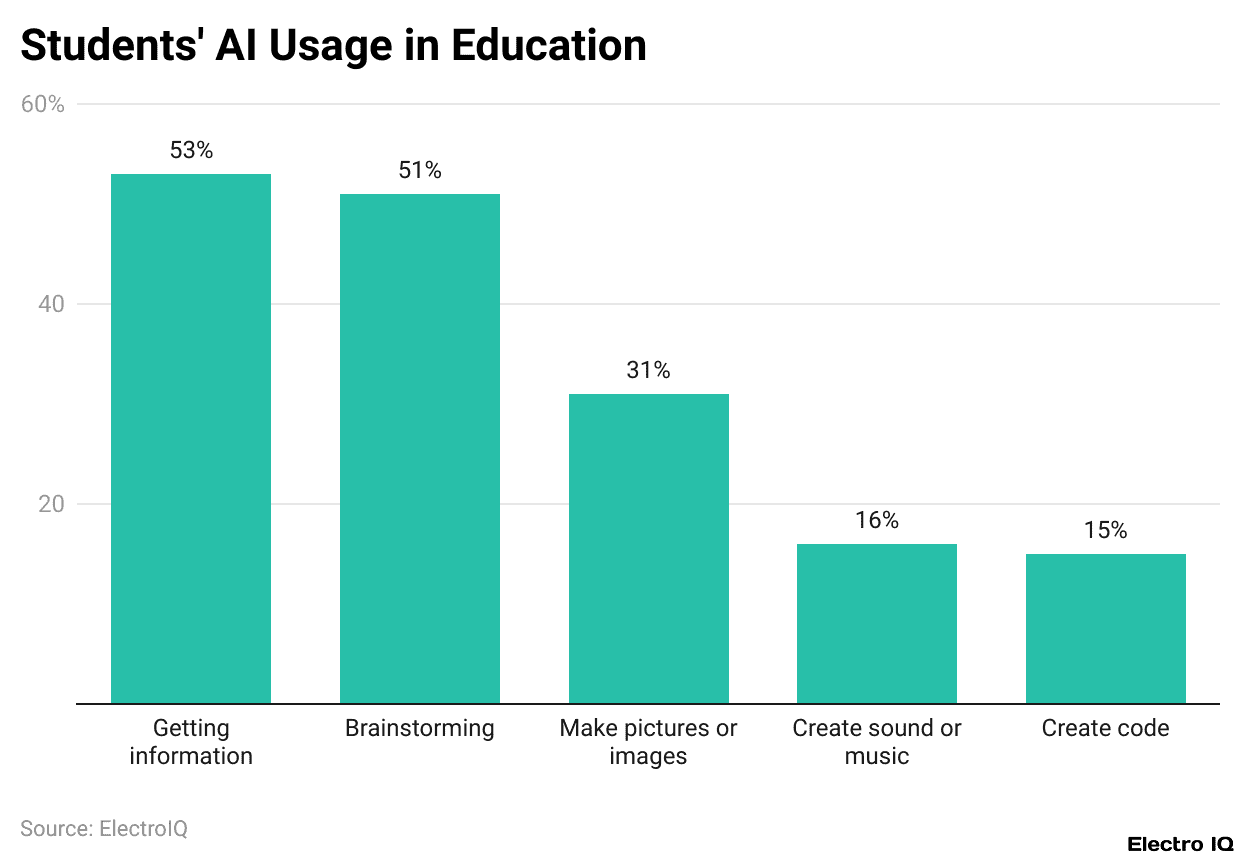
(Reference: demandsage.com)
- AI applications in schooling are primarily used by pupils in the 14- to 22-year-old age bracket, with generative AI tools accessed by approximately 51% of this age group.
- Among young adults, 31% are engaged with the AI for image generation, 16% for audio/musical creation, and 15% for programming.
- When it comes to the students’ educational activities, 53% gather information through AI, 51% get help with idea brainstorming, 31% create images, 16% make sounds/music, and 15% write code by machines, Harvard GSE says.
- The Digital Education Council’s research indicates that 86% of students are already utilising AI as part of their learning process, demonstrating the extent to which AI tools are integrated into education.
- Alongside education, the AI industry is also seeing a great adoption rate in the business sector, with 78% of companies admitting to using different generative AI skills, according to Stanford HAI 2025.
- Furthermore, approximately 93% of students have experimented with AI tools for school-related tasks a couple of times throughout the semester.
- Interestingly, educational administrators appear to rely even more heavily on AI than students, as 99% of them are AI users.
- This, therefore, emphasises the narrative that artificial intelligence is indeed becoming a major player in both the learning and the management of educational operations.
Most Preferred AI Tools In Education
- The Digital Education Council’s Global AI Student Survey, which included 3,839 students from 16 countries across various academic levels and disciplines, indicates that students of today are using an average of around two AI tools for their coursework.
- ChatGPT emerges as the most popular tool among students, with 66% of users relying on it, followed by Grammarly and Microsoft Copilot, which are used by nearly 25% of students each.
- ChatGPT is a versatile tool that can assist with various academic tasks, while Grammarly primarily focuses on writing and grammar, and Microsoft Copilot is centred on productivity and general assistance.
- Moreover, Microsoft 365 Copilot Chat usage has been linked to a 15% increase in passing rates, as students are more engaged and confident, resulting in improved overall academic performance.
- Brisbane Catholic Education. Microsoft 365 Copilot has been adopted by 12,500 educators and support staff, and has also enabled a group of 13 students to utilise Copilot Chat for brainstorming and confidence-building.
- The remarkable 275% improvement in students’ ability to take control of their learning resulting from this trial is one of the pieces of evidence that AI tools can significantly impact educational outcomes positively.
Use AI In Education By Teachers
| Teacher Group |
Current Usage
|
| K-12 teachers using generative AI | 83% |
| Higher education faculty using AI regularly | 22% |
| Education leaders using AI daily | 47% |
(Source: demandsage.com)
- As per DemandSage, AI in Education statistics show that the adoption of AI among teachers has increased immensely in the last few years.
- According to the Schools of the Future report, nearly 50% of school managers now use AI technology daily, and equal numbers of teachers and school principals (50% and 52% respectively) point to digital learning tools as necessary for monitoring student progress.
- The World Economic Forum acknowledges that 71% of teachers consider AI tools as a must-have for helping students to excel in college and future careers, while about 60% of them have already been embedding AI into their teaching methods.
- The usage of generative AI tools among teachers saw a dramatic increase of 32% from the 2022–2023 to the 2023–2024 school years.
- In the meantime, an overwhelming 83% of K-12 teachers admitted using generative AI tools for either personal or classroom-related purposes, while just 22% of higher education faculty were regular users of AI.
- Moreover, about 47% of education leaders are daily users of it. The data demonstrates that AI has been integrated into modern education, and it is a powerful tool that supports the learning process of students and the administration in the school by making it efficient.
How AI Shapes Student Learning
- The impact of AI in the educational sector has yielded a combination of positive and negative outcomes, as well as the emergence of doubts.
- The general view of 16% of students is that the use of AI is beneficial, while the 14-22 age group believes that in the coming decade, AI will bring both positive and negative consequences.
- According to this group, only 4% say they use AI every day, according to Harvard GSE. A tiny fraction—approximately 2.4%—of the students think that AI has no positive impact on their education.
- At Macquarie University, the use of AI tools, such as chatbots, has been reported to yield academic gains, as evidenced by a 10% increase in student exam results by March 2025.
- Nearly a third (30%) of students are reportedly prone to developing an addiction to AI tools, and about a third (33%) of students have been accused of overusing AI or plagiarising, thereby raising concerns about academic integrity.
- The majority of teachers (more than 25%) view the influence of AI on the education process as negative, while only a small percentage (6%) of K-12 teachers think that AI does more good than harm.
- Moreover, some K-12 educators (32%) have mixed emotions, since they see both sides of the issue and recognise the positive and negative aspects of AI in the classroom.
- Approximately 35% of educators are still not sure about its impact.
- These varying viewpoints suggest that although AI can enhance the educational experience, it remains a challenge that requires careful handling in terms of teaching and assessment practices.
AI Training And Professional Development In Education
| Training Status |
Rate/Percentage
|
| UK students who’ve received AI support from an institution | 36% |
| K-12 teachers with NO AI training (US) | 71% |
| UK staff well-equipped to help with AI | 42% |
| Educators globally who received NO training | 45% |
(Source: demandsage.com)
- The integration of AI and professional development is at the top of the list of educational priorities; however, many educators remain underprepared. RAND’s study indicates that 26% of the districts are going to offer AI training in the 2024-2025 school year.
- 74% of the districts expect to provide training for AI by the fall of 2025. This trend indicates that schools are beginning to recognise the importance of training their teachers to incorporate AI into their instruction.
- The Amazon Assets Report has come to the conclusion that 59% of teachers are in favour of students being at least basic users of AI by the time they start their university course.
- Educators in Tennessee agree with that percentage, with 60% claiming that these skills will be a good investment for students and 69% saying that such abilities will increase students’ chances of getting high-paying jobs in the future.
- In the UK, it is reported that only 36% of the total number of students have had AI assistance from their universities, while 42% of the faculty members consider themselves capable of providing AI support to the students.
- On the other hand, 71% of teachers in the K–12 system are reported to have had no formal training in AI, and 45% of teachers globally say they have not received any training in AI-related topics.
- The disparity between training and demand highlights the need for more structured and accessible AI training programs, as teachers and students still struggle to benefit from the new technologies in education fully.
Benefits of AI In Education By Countries
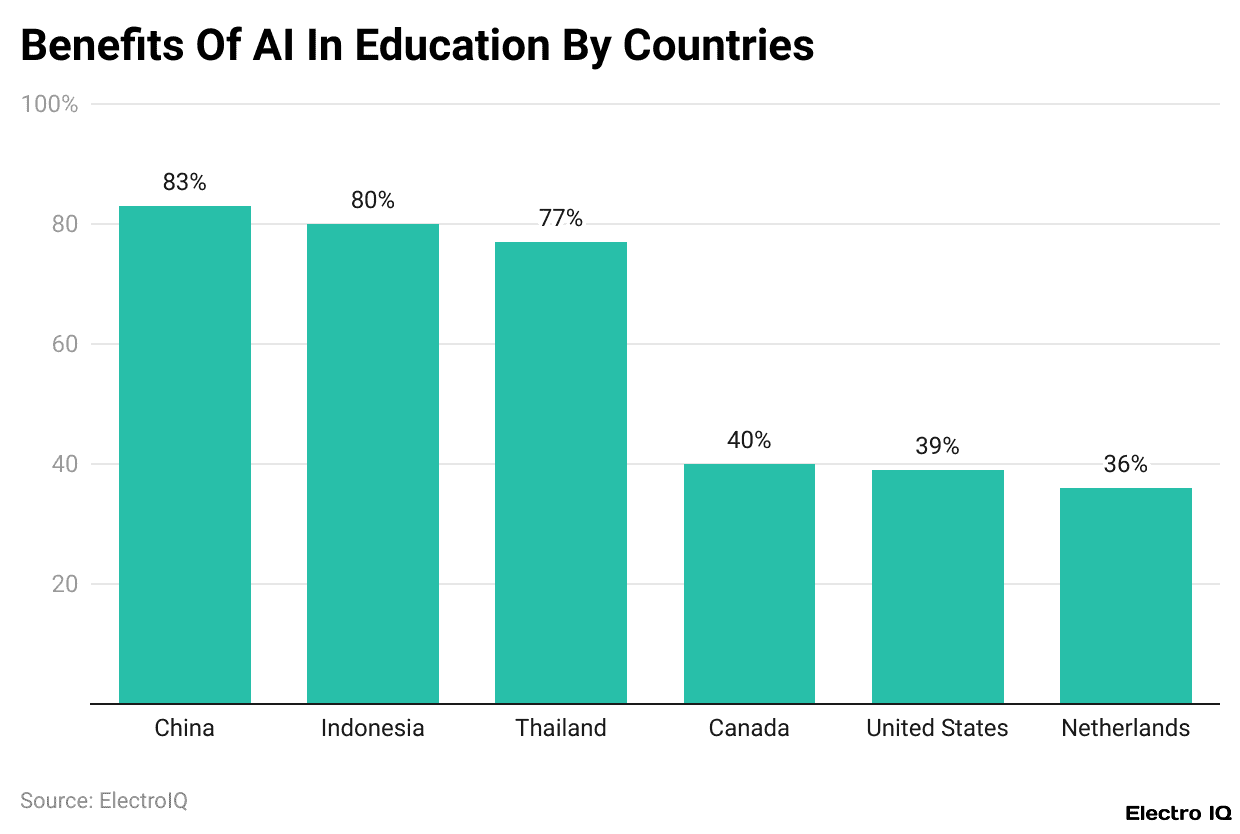
(Reference: demandsage.com)
- The worldwide scenario from an AI adoption and investment point of view varies a lot, with the U.S. being the major player in the private AI funding.
- In 2023, the U.S. saw US$109.1 billion in private AI investment, which is nearly 12 times larger than China’s US$9.3 billion and 24 times more than the U.K.’s US$4.5 billion.
- The huge U.S. financial backing indicates that AI will not only be widely used but also in an accelerated manner in the coming years.
- Conversely, different countries have varying views on the benefits of AI. China is on top of the list with 83% people positively rating AI, and then comes Indonesia with 80% and Thailand with 77%.
- Western nations, on the other hand, show very low optimism: only 40% of Canadians, 39% of Americans, and 36% of people in the Netherlands consider AI a good thing.
- The main reason behind such differences is the amount of trust, familiarity, and AI technologies being used in the education systems and societies of those nations.
AI In Education – Differences In Gender And Attitude of Usage
- The use among students is becoming more and more common; 44% of kids are involved in generative AI, and more than 54% are using it for school or homework.
- Yet, male and female students differ quite a lot in their usage and perceptions of AI tools.
- According to ResearchGate, male students are found to have a higher frequency of AI use, with an average usage score of 3.14, compared to 2.73 for females.
- Moreover, gender differences can be traced in terms of emotional and social aspects of AI use.
- Pew Research has cited a figure of 21% male students feeling overwhelmed by AI against 30% female students.
- As far as social learning is concerned, 63% of boys and 70% of girls admit that AI makes them more aware of their friends.
- On the same note, 56% of male students and 65% of female students state that AI tools facilitate their communication with relatives to a greater extent.
- The study conducted by HEPI with 1,041 full-time undergraduate students revealed that women were more concerned in general than men about academic misconduct and incorrect results stemming from AI usage.
- In contrast, men showed more optimism about AI’s capabilities. Similar excitement and, consequently, adoption could be observed among well-to-do and STEM students.
- Predictions for 2025 indicated that the number of students using AI overall increased from 66% in 2024 to 92%, while the use of generative AI for assessments rose from 53% to 88%.
- Such occurrences indicate that, although AI is being recognised as a vital aspect of education, gender and socio-economic factors are still influencing students’ perceptions and engagement with these technologies.
Challenges And Limitations of AI In Education
- Despite the rapid rise of AI in classrooms, many educators face significant challenges in effectively integrating it into teaching.
- Only about a quarter of teachers have received any training on AI chatbots, and nearly one-third cite a lack of training or professional development as the main barrier to adoption.
- In fact, 96% of K–12 teachers in the U.S. report not receiving formal AI training, and 85% feel unprepared to manage generative AI use in their classrooms.
- Around 33% say they feel supported in using AI, with training sessions being the most beneficial resource.
- Educators also express concerns about AI’s impact on learning quality and ethics.
- Over 60% worry that AI could harm students’ independent thinking and writing skills, while 72% cite plagiarism and cheating as major issues.
- A large number of teachers (76%) and students (65%) share the opinion that AI usage during exams or homework is a kind of cheating; still, a quarter of students consider AI as a tool for writing assignments.
- Moreover, the vast majority of teachers (93%) and students (79%) think that there is a need for regulations to control the application of AI in education.
- Teachers are already confused about the right usage of AI and its possible long-term impact on student engagement and academic integrity, as the schools are still without clear AI policies.
Conclusion
AI in Education Statistics: AI is substantially transforming the education sector, bringing about significant changes in teaching practices and learning methods. It has assisted teachers in various areas, such as lesson planning and research, while students have utilised it for personalised learning and academic support, thereby increasing engagement and efficiency on both sides. On the other hand, the rapid adoption of AI technology has also raised several issues, including ethical concerns, over-reliance on these tools, and the problem of unequal access to training.
This new aspect of education is still puzzling for the teachers and institutions, and they are trying to strike a balance between the two extremes of innovation and integrity. The very backbone of future education turns out to be proper use of AI—the use of artificial intelligence in a way that, together with teachers and learners, it creates a constructive environment based on the values of critical thinking and academic honesty.
FAQ.
AI is a major factor that is rapidly changing the education sector by making administrative work easier, improving teaching quality, and personalising student learning. The global AI in education market is expected to reach US$6 billion by 2025 due to the highest acceptance in schools and universities.
Amongst the various available AI tools, ChatGPT has taken over the world as the most popular tool being utilised for writing, researching, and solving problems by 66% of students. Following that is Grammarly with Microsoft Copilot, which is used by 25% of students each. Teachers, too, are riding the AI wave for their daily activities, such as lesson planning, grading, and preparing classroom materials, as 83% of K–12 teachers reported using generative AI.
In spite of the increasing use of AI, a large number of teachers still do not receive the necessary training. In the United States, 71% of K–12 teachers do not have any AI training, and 85% of them feel they are not ready to deal with the situation of generative AI in classrooms. However, efforts are being made—by Fall 2025, 74% of school districts will be providing AI training.
There are mixed feelings about AI. A significant number of students and lecturers see the higher level of creativity and academic performance as the plus points of AI, still issues around dependency and academic integrity are being raised. Approximately 72% of teachers consider plagiarism to be a serious problem, while 60% are concerned that AI could have a negative impact on students’ critical thinking.
The United States is at the top of the list in global AI investment, with a whopping US$109.1 billion coming from private funding, which is significantly higher than both China and the U.K. combined. This investment is responsible for the swift growth in educational AI tools. Nonetheless, the perception of AI benefits fluctuates from one region to another: China (83%), Indonesia (80%), and Thailand (77%) are among the most optimistic countries, while the U.S. (39%) and Canada (40%), belonging to Western nations, are still hesitating to a certain extent.

I hold an MBA in Finance and Marketing, bringing a unique blend of business acumen and creative communication skills. With experience as a content in crafting statistical and research-backed content across multiple domains, including education, technology, product reviews, and company website analytics, I specialize in producing engaging, informative, and SEO-optimized content tailored to diverse audiences. My work bridges technical accuracy with compelling storytelling, helping brands educate, inform, and connect with their target markets.






